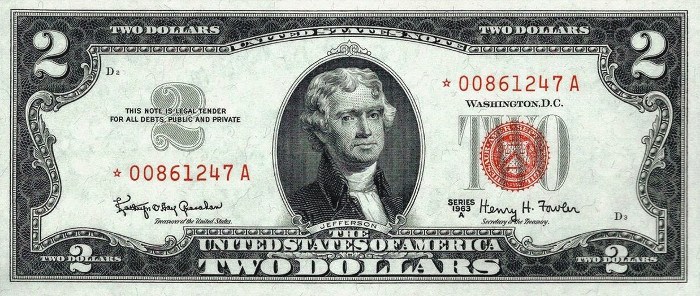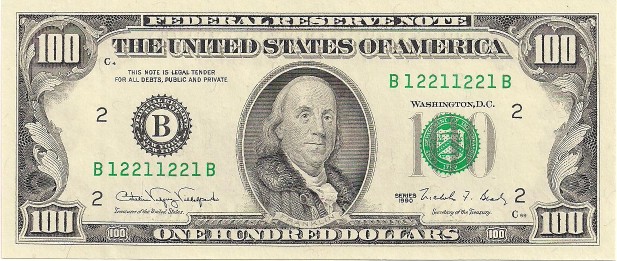Double Denomination
A double denomination note has differing face and back values, for example a $5 face with a $10 back. Double denomination errors are exceedingly rare and valuable. The number in existence is very low. If you find one on eBay or for sale from a source otherwise not confirmed to be knowledgeable, it is likely that the note is not genuine.
Faulty Alignment (aka Miscut)
Faulty alignment errors are characterized by once side of a note being properly centered, while the other is shifted to some degree. Shifting may be only minor or may be dramatic. These errors are relatively common and widely collected.
The above example, graded PCGS 30PPQ (Very Fine) sold for $50
Insufficient Inking
Insufficient inking errors result from poorly or inadequately filled printing plates. As a result, the note displays an image that is faint or not fully complete. Like other currency errors, insufficient inking may be only minor, or may affect large parts of the note. Most errors of this type have insufficient inking of the 1st or 2nd printing.
This Series 1963B $1 PCGS graded 64PPQ sold for $871
Inverted Back
Inverted back errors might also be called notes with upside-down backs. This type of error is caused by a sheet being fed incorrectly (rotated 180 degrees) into the printing press for printing of the face (backs are printed first). Inverted back errors are not very common and command relatively high premiums.
Blank Back or Blank Reverse
A blank back error note is one that has printing on one side, but no printing on the other. These errors are often caused by two sheets being fed into a printing press at the same time.
This complete blank back error was graded 66PPQ by PCGS and sold for $500
Double or Multiple Impressions
Multiple impression errors usually display an image that appears “blurry” or “fuzzy”, and may occur when a sheet is mistakenly re-fed through the press after receiving printing, or a sheet staying in place after being printed and receiving a second impression of the same design.
Obstructed Printings
Obstructed printing errors occur when a piece of material (usually a stray piece of paper, tape, wrapping, etc) comes between the printing plate and the uncut sheet. The result is a portion of a note with blank area. Obstructed printings are popular with error collectors, with value increasing dramatically when the item causing the obstruction is retained with the error note.
This 1977 $20 obstruction error was graded 58 EPQ (Choice Almost Uncirculated) by PMG
Offset Printing or Offset Transfer
Offset printed notes occur when an inked plate makes contact with the bed, often the cause of no sheet being fed to the press to accept the intended ink. As a result, when the next sheet passes through the press, the area impressed onto the impression cylinder is then pressed onto the opposite side of the note. Like others, this type of error can range from minor to a complete offset, with the latter being more desirable to collectors. While a rational theory, note that the errors described or pictured here are not caused by wet sheet transfer, or ink transferring from still-wet sheets to other sheets.
The Series 1974 offset transfer above sold for $140
Reverse Overprints (3rd Print on back)
Back overprint errors are the result of an uncut sheet being fed into a press with the obverse of the note facing the overprinting press. The information printed by the overprinting press include Treasury and Federal Reserve District seals, district numbers and serial numbers. Such a note will be missing these elements from the front, and instead have each displayed on the back.
This Series 1981 overprint error was graded PCGS 63PPQ and sold for $355
Inverted Overprint (3rd Print)
When a sheet is fed upside down relative to the existing face print, the result is the Treasury Seal, District Seal, District Number and serial numbers being printed upside down. Inverted 3rd print errors are not especially rare.
This Series 1974 $1 with inverted overprint graded 25PPQ by PCGS and sold for $202
Misaligned Overprints (Shifted 3rd Print)
When overprints (3rd printing) occur when the serial numbers and seals are out of position, vertically or horizontally, and are so far from their appropriate position that they cover unintended portions of the note. For example, a District seal might be so far misaligned that it covers the portrait on the face of the note. Again, errors range from minor, to major, with major errors being more desirable to collectors.
This Series 1974 shifted overprint example sold for $130
Missing Overprint (3rd Print)
A note with a missing overprint is easily recognizable because the bill lacks serial numbers and seals.
This Series 1995 missing overprint note sold for $325
Missing 2nd Printing
Similar to Missing Overprints, a note with a missing 2nd print is recognizable because the note is missing its face printing. Therefore no subject or denomination is displayed on the note.
The above $10 graded PCGS 66PPQ and sold for $1000
Mismatched Serial Numbers
On regular notes, both serial numbers on the front of the note are the same. Mismatched serial errors are characterized by numbers (or alpha characters) not matching on the same note. There are several different causes for this type of error. Notes with more than one digit mismatched are more valuable than those with a single mismatched number. Additionally, notes with mismatched characters are more scarce than notes with mismatched numbers.
This mismatched serial Series 1969D $1 graded 55PPQ by PCGS sold for $412
Stuck Digits
When the serial number digits freeze in place or get otherwise stuck during the printing process, the result is a stuck digit or partially turned digit.
Cutting Errors
After printing is complete, the uncut sheets of notes are sent to be cut into single notes. Like the previous printing process many errors can occur during the process of printing, ranging from minor to quite dramatic.
Gutter Fold or Blank Crease
Gutter folds are the result of the uncut sheets being sent through the press with a wrinkle or wrinkles in the paper. A gutter fold error note may have one wrinkle or multiple wrinkles. While collectible, these errors are relatively common.
This 1950A $10 was graded PCGS 35 (VF) and sold for $88
Printed Fold
A printed fold occurs when an uncut sheet folds over and remains this way during the printing process. As such, these type of errors range widely depending on the size and nature of the fold.
This printed fold error was graded 63PPQ by PCGS and sold for $193
Ink Smears
As the name implies, an ink smear error occurs when smears of ink are passed from the press onto a note. Ink smears are not hard to duplicate or fake, so be wary when purchasing.
This ink smear example graded 35PPQ (VF) by PCGS and sold for $45



